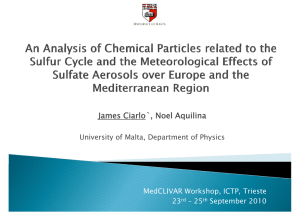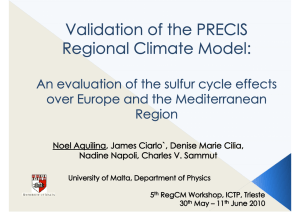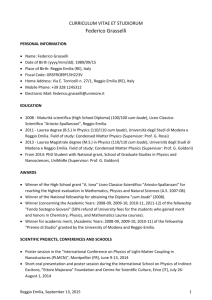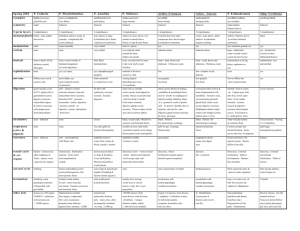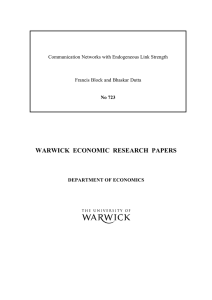Indirect Exports and Wholesalers: Evidence from Interfirm Transaction Network Data
advertisement
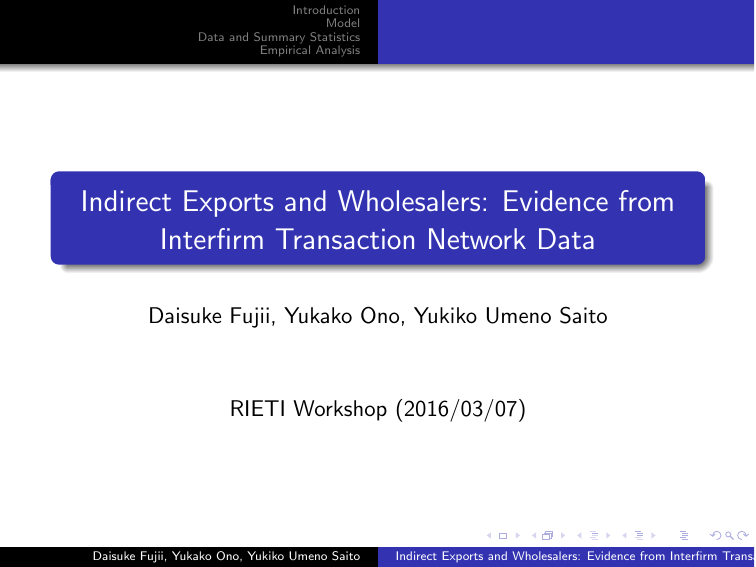
Introduction Model Data and Summary Statistics Empirical Analysis Indirect Exports and Wholesalers: Evidence from Interfirm Transaction Network Data Daisuke Fujii, Yukako Ono, Yukiko Umeno Saito RIETI Workshop (2016/03/07) Daisuke Fujii, Yukako Ono, Yukiko Umeno Saito Indirect Exports and Wholesalers: Evidence from Interfirm Transa Introduction Model Data and Summary Statistics Empirical Analysis Section 1 Introduction Daisuke Fujii, Yukako Ono, Yukiko Umeno Saito Indirect Exports and Wholesalers: Evidence from Interfirm Transa Introduction Model Data and Summary Statistics Empirical Analysis Motivation Wholesalers play an important role in facilitating international trade U.S: Wholesale and retail firms account for 11 and 24% of exports and imports (Bernard et al. 2007) Japan: Wholesalers account for 25% of exports in 2014 (Kikatsu) Studies on a mechanism behind firms’ export mode choices are important in understanding factors that expand a market scope for firms/ role of wholesalers Still not many empirical evidence is accumulated other than Bernard et al. (2012, 2014) and Ahn (2011) Daisuke Fujii, Yukako Ono, Yukiko Umeno Saito Indirect Exports and Wholesalers: Evidence from Interfirm Transa Introduction Model Data and Summary Statistics Empirical Analysis Goal of this paper We examine manufacturers’ choice of export mode to understand the mechanism behind their choice and wholesalers’ roles Use Japanese interfirm transaction network data and analyze the features of non-, indirect, and direct exporters firms’ productivity (sales, sales per employment) domestic transaction network (N of suppliers, N of customers) Run multinomial logit regressions to see the determinants of di↵erent export status Build a simple Melitz-type model in which firms can also export via wholesalers (indirect exporting) Investigate industry heterogeneity Daisuke Fujii, Yukako Ono, Yukiko Umeno Saito Indirect Exports and Wholesalers: Evidence from Interfirm Transa Introduction Model Data and Summary Statistics Empirical Analysis Role of wholesalers Wholesalers can reduce the fixed cost of exporting for manufacturing firms distribution (for sellers) and procurement (for buyers) efficient matching risk sharing mitigating adverse selection: guarantee payment (for sellers) and quality (for buyers) Daisuke Fujii, Yukako Ono, Yukiko Umeno Saito Indirect Exports and Wholesalers: Evidence from Interfirm Transa Introduction Model Data and Summary Statistics Empirical Analysis Literature review Empirics of intermediated trade Ahn et al. (2011), Bernard et al. (2012, 2014), Feenstra and Hanson (2001) Theory of intermediated trade Antras and Costinot (2010, 2011), Ackerman (2014) Value-added exports and input-output model WIOD, Caliendo and Parro (2014) Our study uses large Japanese firm-level data We also incorporate information on domestic transaction network Daisuke Fujii, Yukako Ono, Yukiko Umeno Saito Indirect Exports and Wholesalers: Evidence from Interfirm Transa Introduction Model Data and Summary Statistics Empirical Analysis Section 2 Model Daisuke Fujii, Yukako Ono, Yukiko Umeno Saito Indirect Exports and Wholesalers: Evidence from Interfirm Transa Introduction Model Data and Summary Statistics Empirical Analysis Summary A simple trade model with heterogeneous firms, but firms can also export indirectly via wholesalers Direct export: a large fixed cost, but small variable cost Indirect export: a small fixed cost (due to cost sharing through wholesalers) but high variable cost (due to double marginalization) Implication –> Sorting of firm size/productivity into direct, indirect and non-export status Daisuke Fujii, Yukako Ono, Yukiko Umeno Saito Indirect Exports and Wholesalers: Evidence from Interfirm Transa Introduction Model Data and Summary Statistics Empirical Analysis Export profits Export profits and sorting Ind 0 re Di c x te po rt pr ct ire ex po rt p t rofi t ofi f^I Domestic firms Indirect exporters Direct exporters f^D Productivity (size) Daisuke Fujii, Yukako Ono, Yukiko Umeno Saito Indirect Exports and Wholesalers: Evidence from Interfirm Transa Introduction Model Data and Summary Statistics Empirical Analysis Section 3 Data and Summary Statistics Daisuke Fujii, Yukako Ono, Yukiko Umeno Saito Indirect Exports and Wholesalers: Evidence from Interfirm Transa Introduction Model Data and Summary Statistics Empirical Analysis Data TSR firm-level data in 2014 We focus on manufacturing and wholesaling sectors (they account for more than 80% of exporters) –> 120,000 manufacturing firms For each firm, we observe sales, employment, industry (4-digit JSIC), address, and whehter a firm exports or not, etc. Transaction partner information We can identify firms that supply their goods to exporting wholesalers Export mode Direct: manufacturing firms who report they are exporting Indirect: manufacturing firms who supply their products to exporting wholesalers Domestic: other manufacturing firms Daisuke Fujii, Yukako Ono, Yukiko Umeno Saito Indirect Exports and Wholesalers: Evidence from Interfirm Transa Introduction Model Data and Summary Statistics Empirical Analysis Summary statistics domestic indirect direct Total domestic indirect direct Total # of firms 91363 22368 6820 120551 Total sales 7.76E+10 7.98E+10 2.04E+11 3.61E+11 Mean of log sales 12.09 13.13 14.57 12.43 Sales share 0.22 0.22 0.56 1.00 Daisuke Fujii, Yukako Ono, Yukiko Umeno Saito Median 11.99 13.02 14.36 12.25 Total Employment 2425321 1469724 2585678 6480723 SD 1.52 1.68 2.04 1.72 Emp share 0.37 0.23 0.40 1.00 Indirect Exports and Wholesalers: Evidence from Interfirm Transa Introduction Model Data and Summary Statistics Empirical Analysis CDF of sales Daisuke Fujii, Yukako Ono, Yukiko Umeno Saito Indirect Exports and Wholesalers: Evidence from Interfirm Transa Introduction Model Data and Summary Statistics Empirical Analysis CDF of sales by industry Daisuke Fujii, Yukako Ono, Yukiko Umeno Saito Indirect Exports and Wholesalers: Evidence from Interfirm Transa Introduction Model Data and Summary Statistics Empirical Analysis CDF of sales by industry Daisuke Fujii, Yukako Ono, Yukiko Umeno Saito Indirect Exports and Wholesalers: Evidence from Interfirm Transa Introduction Model Data and Summary Statistics Empirical Analysis CDF of other variables Daisuke Fujii, Yukako Ono, Yukiko Umeno Saito Indirect Exports and Wholesalers: Evidence from Interfirm Transa Introduction Model Data and Summary Statistics Empirical Analysis Section 4 Empirical Analysis Daisuke Fujii, Yukako Ono, Yukiko Umeno Saito Indirect Exports and Wholesalers: Evidence from Interfirm Transa Introduction Model Data and Summary Statistics Empirical Analysis Multinomial logit model Firms’ discrete choice problem –> latent utility model Type I extreme value distribution –> multinomial logit model Probability of direct exporting is Pr [i=direct] = ⇣ 0 exp Xi 0 1 + exp Xi D ⌘ 0 + exp Xi I D Probability of indirect exporting is Pr [i=indirect] = ⇣ 0 exp Xi 0 1 + exp Xi Daisuke Fujii, Yukako Ono, Yukiko Umeno Saito I I ⌘ 0 + exp Xi D Indirect Exports and Wholesalers: Evidence from Interfirm Transa Introduction Model Data and Summary Statistics Empirical Analysis Baseline estimates (1) (2) (3) (4) export type indirect direct indirect direct indirect direct indirect direct log sales 0.404*** (0.00484) 0.805*** (0.00773) 0.190*** (0.00715) 0.486*** (0.0122) 0.452*** (0.0135) 0.729*** (0.0223) 0.133*** (0.00626) 0.536*** (0.0101) -6.488*** (0.0626) -13.22*** (0.109) -4.536*** (0.0782) -9.883*** (0.149) 0.781*** (0.0112) -4.420*** (0.0699) 0.781*** (0.0174) -11.16*** (0.121) 0.104*** (0.00754) 0.102*** (0.0138) 0.739*** (0.0125) -4.131*** (0.0812) 0.403*** (0.0138) 0.361*** (0.0253) 0.647*** (0.0196) -9.806*** (0.153) log in-degree log outdegree Intercept Observations 2-digit JSIC FE prefecture FE Pseudo R2 120,551 No No 0.104 120,551 No No 0.118 Daisuke Fujii, Yukako Ono, Yukiko Umeno Saito 120,551 No No 0.142 120,551 No No 0.144 Indirect Exports and Wholesalers: Evidence from Interfirm Transa Introduction Model Data and Summary Statistics Empirical Analysis Estimates with fixed e↵ects (1) (2) (3) (4) export type indirect direct indirect direct indirect direct indirect direct log sales 0.408*** (0.00512) 0.826*** (0.00859) 0.147*** (0.00751) 0.593*** (0.0129) 0.441*** (0.0146) 0.793*** (0.0236) 0.110*** (0.00661) 0.530*** (0.0111) -6.477*** (0.0767) -15.21*** (0.158) -4.081*** (0.0910) -11.52*** (0.193) 0.867*** (0.0120) -4.056*** (0.0846) 0.871*** (0.0193) -12.83*** (0.168) 0.0539*** (0.00794) 0.186*** (0.0145) 0.791*** (0.0133) -3.519*** (0.0945) 0.386*** (0.0149) 0.398*** (0.0269) 0.715*** (0.0219) -11.35*** (0.196) log in-degree log outdegree Intercept Observations 2-digit JSIC FE prefecture FE Pseudo R2 120,549 Yes Yes 0.157 120,549 Yes Yes 0.175 Daisuke Fujii, Yukako Ono, Yukiko Umeno Saito 120,549 Yes Yes 0.199 120,549 Yes Yes 0.201 Indirect Exports and Wholesalers: Evidence from Interfirm Transa Introduction Model Data and Summary Statistics Empirical Analysis Results: productivity measures Intercepts for “Direct” and “Indirect” are lower than “Doemstic” Existence of fixed export-costs Intercept for “Direct” is lower than “Indirect” Fixed export-costs are lower for indirect than direct trades => Shared by other firms using the same wholesaler) Sales slope are positive: higher variable costs Transportation costs, tari↵ etc.) Sales slope for “Indirect” is steeper than “Direct” Marginal costs might be higher for “Indirect” trade Results are robust and consistent with the theoretical model and robust Daisuke Fujii, Yukako Ono, Yukiko Umeno Saito Indirect Exports and Wholesalers: Evidence from Interfirm Transa Introduction Model Data and Summary Statistics Empirical Analysis Intercept and slope by industry Indirect vs Direct (slope) -5 1.2 Indirect vs Direct (intercept) 1 IRON, STEEL RUBBER PRODUCT ICT EQUIP CHEMICAL PRODUCT BUSINESS MACHINE ELECTRONIC PARTS PETROLEUM ELECTRICAL MACHINE PRINTING MISCCERAMIC MANU TRANSPORT EQUIP NON-FERROUS METALS PULP,PRODUCTION PAPER LEATHER PRODUCT TEXTILE PRODUCT MACHINE GENERAL FOOD MACHINE PLASTIC PRODUCT RUBBER PRODUCT FABRICATED METAL LUMBER, WOOD Slope (direct) .6 .8 BEVERAGES, TOBACCO PRODUCTION MACHINE GENERAL MACHINE FABRICATED METAL FURNITURE PLASTIC PRODUCT TEXTILE PRODUCT MISC MANU NON-FERROUS METALS FOOD PULP, PAPER CERAMIC TRANSPORT EQUIP ELECTRICAL MACHINE LUMBER, WOOD BUSINESS MACHINE ELECTRONIC PARTS PETROLEUM PRINTING ICT EQUIPCHEMICAL PRODUCT BEVERAGES, TOBACCO .4 Intercept (direct) -15 -10 LEATHER PRODUCT FURNITURE .2 -20 IRON, STEEL -10 -8 -6 -4 Intercept (indirect) Both 5% significant 45-degree line Other Daisuke Fujii, Yukako Ono, Yukiko Umeno Saito .2 .3 .4 .5 Slope (indirect) Both 5% significant 45-degree line .6 .7 Other Indirect Exports and Wholesalers: Evidence from Interfirm Transa Introduction Model Data and Summary Statistics Empirical Analysis Results: domestic transaction network Higher in-degree raises the probability of both indirect and direct exporting but more for direct exporting A possible explanation is the cost sharing Higher out-degree raises the both probability for about the same magnitude higher out-degree promotes export in general; demand side explanation? Daisuke Fujii, Yukako Ono, Yukiko Umeno Saito Indirect Exports and Wholesalers: Evidence from Interfirm Transa Introduction Model Data and Summary Statistics Empirical Analysis Conclusion Sorting of size into three export status (consistent with the model) Lower intercept and steeper slope of sales for Direct than Indirect Exporting Consistent with our model setup: Fixed costs are lower, and marginal costs are higher for Indirect than Direct exporting In-degree: promotes direct exporting Sharing of fixed costs with other firms using the same wholesaler Out-degree: promotes trade in general Daisuke Fujii, Yukako Ono, Yukiko Umeno Saito Indirect Exports and Wholesalers: Evidence from Interfirm Transa Introduction Model Data and Summary Statistics Empirical Analysis 20 Exporters share by industry Indirect/Direct ratio (in log scale) 5 10 15 LUMBER, WOOD FURNITURE FOOD PRINTING TEXTILE PRODUCT PULP, PAPER FABRICATED METAL IRON, STEEL BEVERAGES, PLASTIC TOBACCO PRODUCT LEATHER PRODUCT RUBBER PRODUCT NON-FERROUS METALS CERAMIC MISC MANU GENERAL MACHINE ELECTRICAL MACHINE PETROLEUM TRANSPORT EQUIP PRODUCTION MACHINE ICT EQUIP ELECTRONIC PARTS CHEMICAL PRODUCT BUSINESS MACHINE .1 .2 .3 .4 Total (direct + indirect) exporters share Daisuke Fujii, Yukako Ono, Yukiko Umeno Saito .5 Indirect Exports and Wholesalers: Evidence from Interfirm Transa Introduction Model Data and Summary Statistics Empirical Analysis Multinomial logit by industry Slope vs Intercept (direct) -10 -4 Slope vs Intercept (indirect) ICT EQUIP BEVERAGES, TOBACCO ICT EQUIP CHEMICAL PRODUCT CHEMICAL PRODUCT LEATHER PRODUCT ELECTRONIC PARTS Intercept (direct) -16 -14 -12 BUSINESSPARTS MACHINE ELECTRONIC Intercept (indirect) -8 -6 ELECTRICAL MACHINE RUBBER PRODUCT TEXTILE PRODUCT BUSINESS MACHINE TRANSPORT EQUIP PETROLEUM TOBACCO CERAMIC BEVERAGES, GENERAL MACHINE MISC MANU PRODUCT PLASTIC FOOD PRODUCTION MACHINE PRINTING NON-FERROUS METALS PULP, PAPER FABRICATED METAL PETROLEUM ELECTRICAL MACHINE PRINTING MISC MANU TRANSPORT EQUIP CERAMIC NON-FERROUS METALS PULP, PAPER LEATHER PRODUCTMACHINE TEXTILE PRODUCT PRODUCTION GENERAL MACHINE FOOD PRODUCT LUMBER, WOODPLASTIC RUBBER PRODUCT FABRICATED METAL FURNITURE FURNITURE -18 -10 IRON, STEEL LUMBER, WOOD .2 .3 .4 .5 Slope (indirect) Both 5% significant .6 Other Daisuke Fujii, Yukako Ono, Yukiko Umeno Saito .7 IRON, STEEL .4 .6 .8 Slope (direct) Both 5% significant 1 1.2 Other Indirect Exports and Wholesalers: Evidence from Interfirm Transa Introduction Model Data and Summary Statistics Empirical Analysis Scatter plots by industry Scatter Matrix of Industry Characteristics .1 .2 .3 12 12.5 13 13.5 .2 direct exporters share .1 0 .3 indirect exporters share .2 .1 10 log of # of firms 8 6 13.5 mean of log sales 13 12.5 12 2.5 SD of log sales 2 1.5 0 .1 .2 6 Daisuke Fujii, Yukako Ono, Yukiko Umeno Saito 8 10 1.5 2 2.5 Indirect Exports and Wholesalers: Evidence from Interfirm Transa
